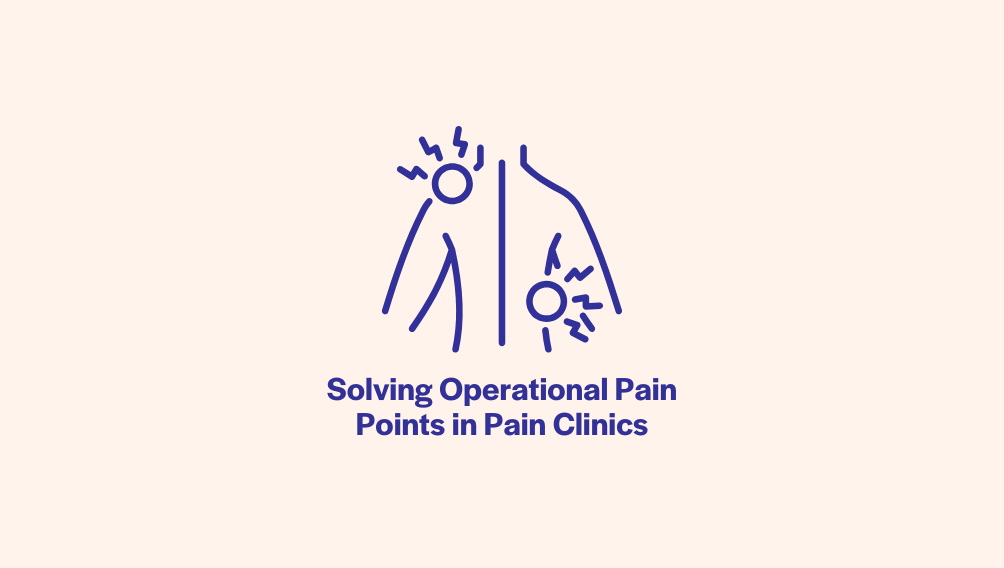Solving Operational Pain Points in Pain Clinics

In pain management clinics, time equals revenue. When a patient misses a procedure like an injection or ablation, the slot often can’t be filled, and the clinic loses income it can’t get back. Staff are left scrambling, and patients are left without the care they need.
Behind each no-show or late cancellation is a web of challenges: confusing instructions, last-minute insurance issues, unclear follow-up steps. The cost is more than financial. It also disrupts care and stresses staff.
“We’re constantly losing revenue from no-shows, especially for follow-up procedures patients forget about,” said one clinic manager.
These visits are high-value and time-sensitive. If the clinic can’t connect the dots between referral, prep, and arrival, the opportunity is gone and may not come back for weeks.
The Pre-Auth Problem
Getting procedures approved by insurance is rarely smooth. Every payer has its own rules. Some require supporting notes, others need step therapy, and nearly all involve long waits.
One clinic leader put it bluntly: “Pre-auth and intake are still way too manual. My staff is drowning in paperwork.”
When prior authorization requests get stuck, it slows everything. A delay in approval can mean a canceled appointment. Patients wait longer, schedules shift, and everyone gets frustrated. Some clinics have teams dedicated to handling pre-auth, but even then, they’re stretched thin.
Technology that automates parts of this process, like flagging missing information or triggering follow-ups, can save hours each week. More importantly, it helps ensure patients don’t have to wait for pain relief.
Referrals Without Follow-Through
Pain management clinics often rely on referrals from primary care, ortho, or neurology. But referrals don’t always turn into appointments.
“It’s hard to tell which referrals we’ve lost until someone calls to ask if we’ve reached out yet,” one admin shared.
That lag in outreach is a major source of revenue leakage. And it’s not just about lost money. It’s lost care. Patients are left waiting, or they go elsewhere.
Using tools that automatically capture incoming referrals and send a text or email to invite the patient to schedule can plug this gap. Clinics that streamline this process see more visits scheduled, faster turnaround, and fewer missed opportunities.
Scheduling That Actually Works
Scheduling procedures is complex. It involves the surgeon or interventionalist, the anesthesia team, available room time, and patient preferences. Juggling it all manually often leads to missed opportunities.
“I have no clear view into our waitlist or how long patients are waiting to get in,” said one practice leader.
When patients cancel or don’t show, those valuable slots go unused. Meanwhile, others are still on hold waiting for an appointment.
Smart scheduling tools that incorporate waitlists, cancellation re-fills, and time block management give teams a clearer view. That means fewer wasted hours, more completed procedures, and less staff stress.
The Lost Follow-Up
Pain care doesn’t end after the procedure. Patients often need follow-up visits to check results, adjust medications, or discuss next steps.
But many clinics fall short on this front.
“We finish the procedure but don’t always follow up, and that shows up in our reviews,” one leader noted.
When patients feel forgotten, they’re less likely to return or recommend the practice. That can hurt both reputation and revenue.
Simple post-visit workflows, like an automatic message to check on recovery or prompt the next appointment. go a long way in keeping patients engaged and cared for.
Where Smart Tools Help
Luma Health works with pain management clinics to tackle exactly these problems. But it’s not about adding more tools. It’s about reducing the load.
Our customers use automation to:
- Cut no-show rates with behavior-based reminders
- Keep waitlists full by filling cancellations automatically
- Streamline intake and prior auth with digital forms and tracking
- Improve follow-up with post-procedure messaging
Instead of relying on staff to remember every task, the system helps them focus on the work that matters most: caring for patients.
Three Quick Wins for Pain Clinics
Want to start improving your operations right away? Try these ideas:
- Check your no-show data. Look at the last 90 days. What’s the most missed appointment type? Is there a reminder problem? A prep issue?
- Centralize referral tracking. A shared tracker or lightweight tool can help your team follow up faster and more reliably.
- Ask your team. Where are they spending the most time on admin work? Their answers will point you to the biggest opportunities for automation.
Running a pain management clinic is tough. You’re dealing with complex care, strict schedules, and stressed-out patients, all while trying to stay profitable.
But even small changes can make a big difference. With the right technology, you can cut down on missed procedures, reduce admin burden, and help your staff do more of what they’re great at.
Want to see how your pain management practice could benefit from smarter workflows and more connected patient experiences? Schedule a personalized demo with the Luma Health team to explore how our platform can help you streamline operations, reduce no-shows, and support your patients every step of the way.